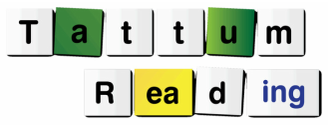
is...
"...Absolutely the BEST decision we ever made." - Kim Olsen
"...The most important five days I have ever spent." - Wendi DeMartini
"...Not just a reading program, it's a way of life." - Mary Steiger
"...The most important five days I have ever spent." - Wendi DeMartini
"...Not just a reading program, it's a way of life." - Mary Steiger
What makes Tattum Reading different?
A full half of each Tattum Reading lesson is spent reading books. The pace of the Tattum Reading program is not dictated by the phonics program, but by the books. The books lead the program. Tattum Reading is not a mastery phonics program, but an integrated reading program. We have found that the daily reading allows the students' vocabulary, syntax, and meaning to enhance student’s word attack, and reduce reversals and inverses. This is the secret to the incredibly fast gains we see our students make. While other programs enthusiastically promise two years of reading growth in two years time, we average two to three years growth in just 20 hours of tutoring!
What does a Tattum Reading lesson look like?
Students begin with the magnetic board.
Sounds: The student will quickly review old and new sounds.
Spelling: The teacher will say sounds and students will point to the letters that represent them on the board.
Reading: The teacher will point to letters on the boards and the student will say the letter’s high frequency sounds.
Syllables: The student will make and read nonsense words that range from 1 to 6 syllables.
Spelling: The teacher will give nonsense syllables that focus on phonetic concepts such as diphthongs and students will spell these on the board using magnetic letters. The teacher will give about 10-12 words that will each require one or two changes in letters.
Reading: The teacher will then make nonsense words on the board that focus on phonetic concepts and the students will read these words.
Words: Direct transfer of phonetic word into daily spelling, reading, and writing.
Spelling: The teacher will dictate high frequency words that address several spelling concepts and the student will write these words on paper. The words that are dictated will address concepts already addressed on the magnetic board.
Reading: Half of the period will be involved in reading in the FAST books. The students will first read words that are listed before each chapter. These words address the phonetic principles in the book. Then the teacher will do pressure release with the students. The student will read until s/he makes two errors, the teacher will then take over for the student and s/he will read with the teacher for two sentences, then the student takes over. This technique allows students to read for half of an hour without frustration.
Writing: The student will compose a 5 minute written response to the reading.
Sounds: The student will quickly review old and new sounds.
Spelling: The teacher will say sounds and students will point to the letters that represent them on the board.
Reading: The teacher will point to letters on the boards and the student will say the letter’s high frequency sounds.
Syllables: The student will make and read nonsense words that range from 1 to 6 syllables.
Spelling: The teacher will give nonsense syllables that focus on phonetic concepts such as diphthongs and students will spell these on the board using magnetic letters. The teacher will give about 10-12 words that will each require one or two changes in letters.
Reading: The teacher will then make nonsense words on the board that focus on phonetic concepts and the students will read these words.
Words: Direct transfer of phonetic word into daily spelling, reading, and writing.
Spelling: The teacher will dictate high frequency words that address several spelling concepts and the student will write these words on paper. The words that are dictated will address concepts already addressed on the magnetic board.
Reading: Half of the period will be involved in reading in the FAST books. The students will first read words that are listed before each chapter. These words address the phonetic principles in the book. Then the teacher will do pressure release with the students. The student will read until s/he makes two errors, the teacher will then take over for the student and s/he will read with the teacher for two sentences, then the student takes over. This technique allows students to read for half of an hour without frustration.
Writing: The student will compose a 5 minute written response to the reading.
Is it Tattum Reading or Tattum FAST Reading?
Tattum FAST Reading is the name of this program in Michigan where it has been well researched and has gained prominence. Nationally the program is referred to as Tattum Reading for copyright reasons.
